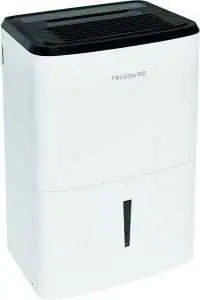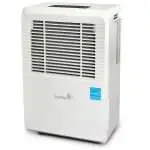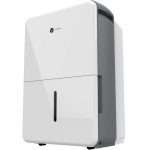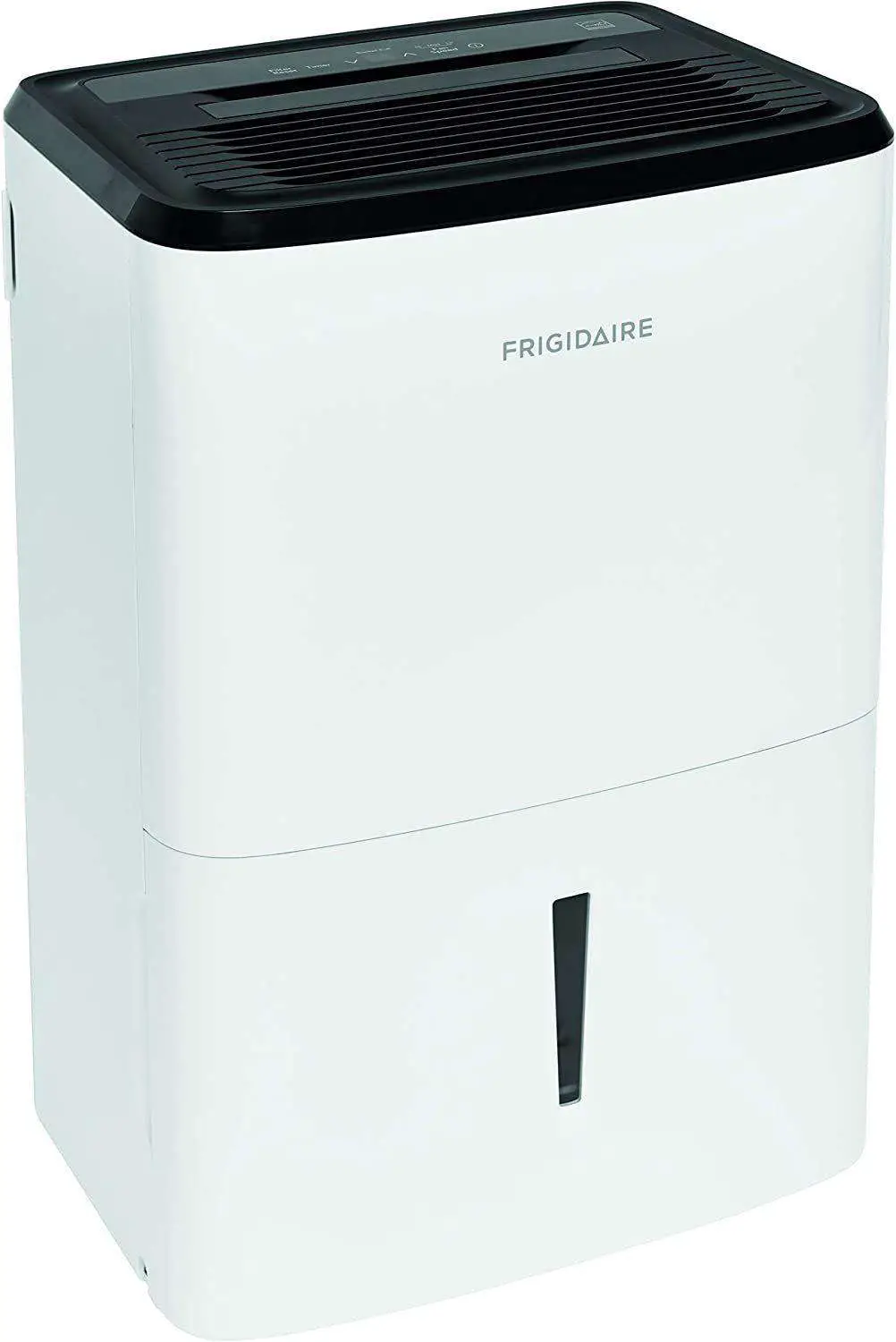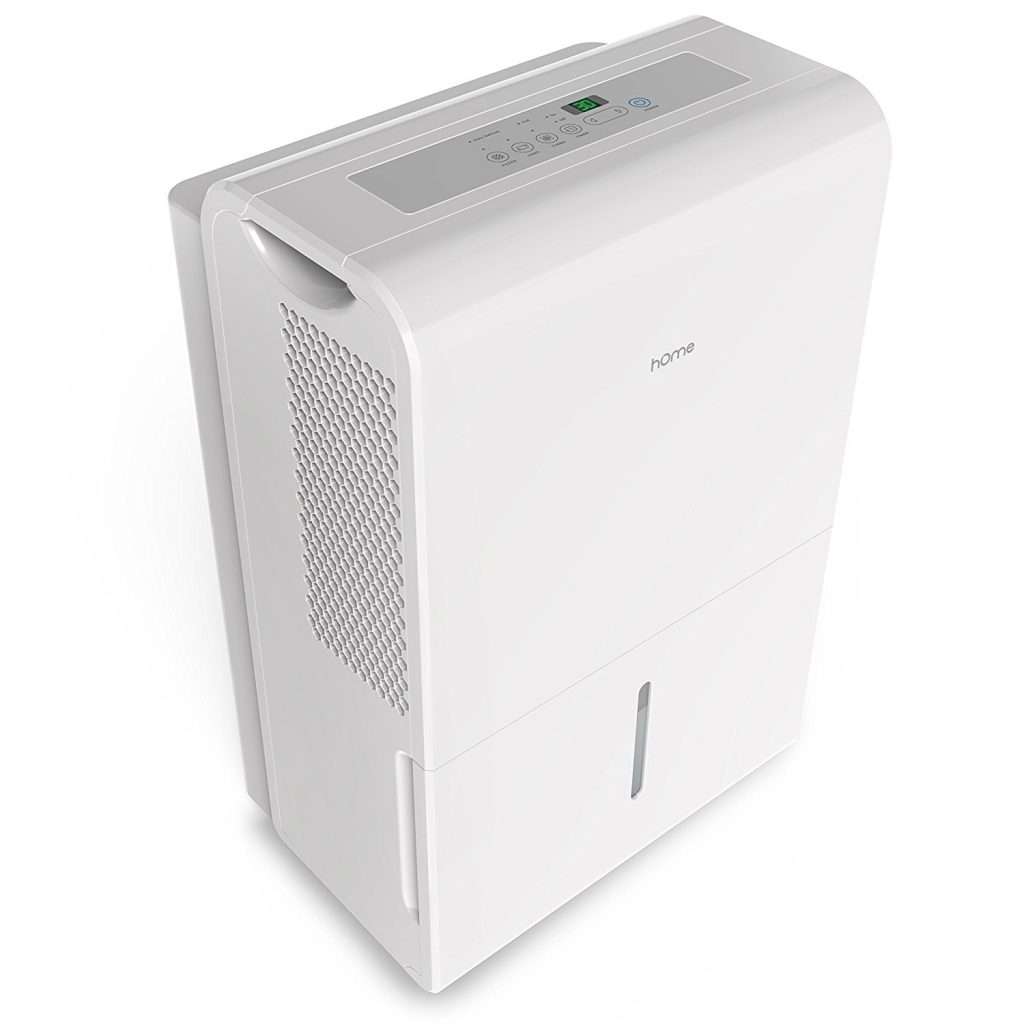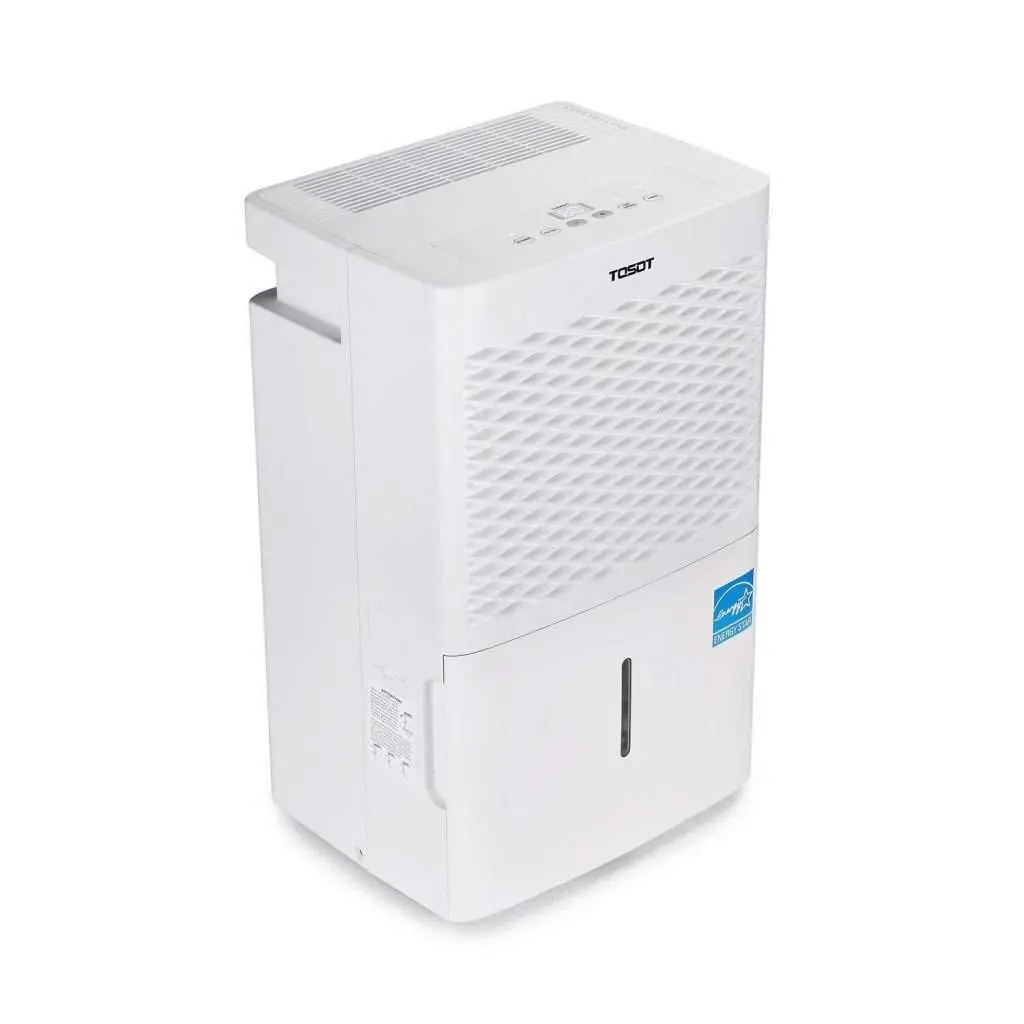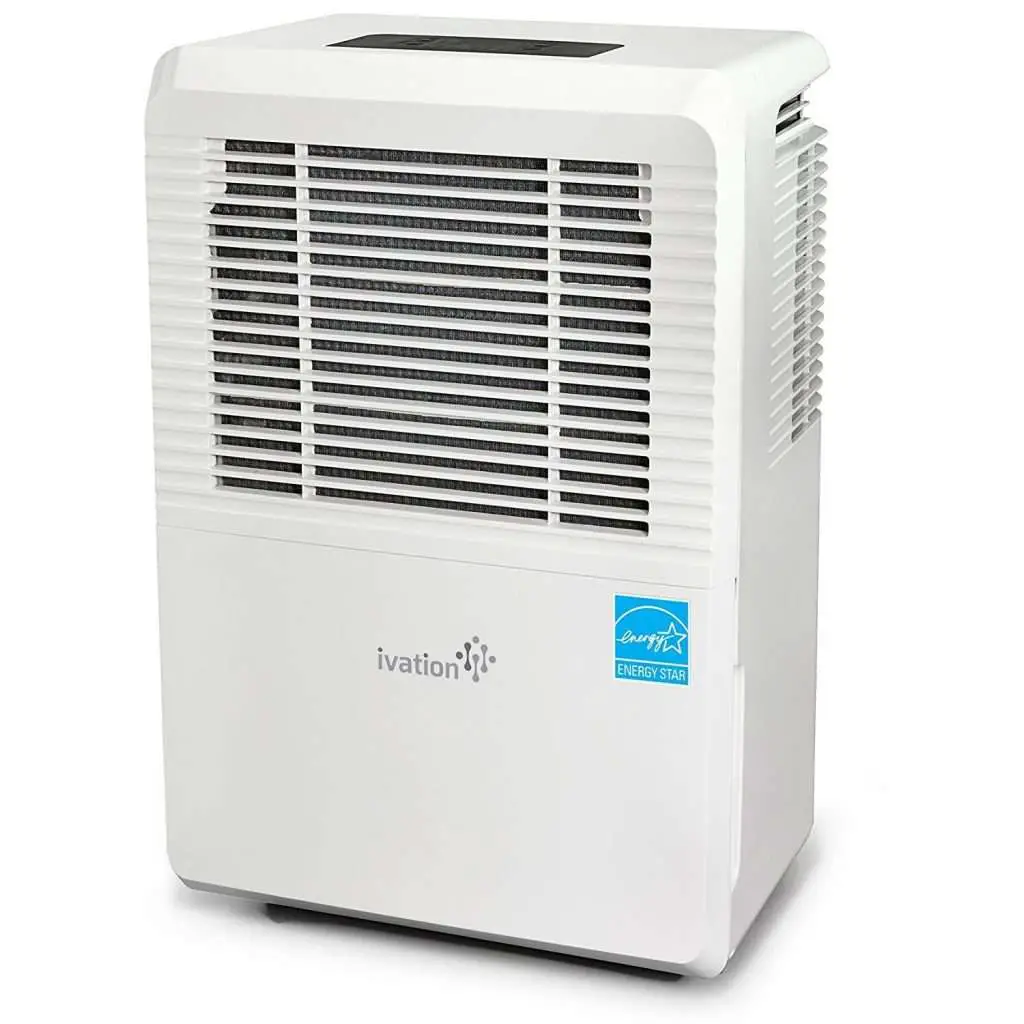Basement dehumidifiers such as Frigidaire and hOmeLabs are the best way to keep your basement dry and mold free. In this guide, we will show you the best basement dehumidifier to buy.
The basement underneath your house can be affected by damp, mold and mildew like the rest of your house. Because basements are often unheated, your basement is more likely to develop a mold outbreak as the air down there is constantly cold, wet and humid.
Mold and damp in a basement is an issue. Damp can cause timber to rot, and many homes in the US are constructed from timber foundations, walls and roofs.
To guarantee your basement stays as dry as possible, we recommend the use of a dehumidifier. We’ve tested several of the best basement dehumidifiers including Frigidaire and have provided our recommendation in this guide which contains basement dehumidifier reviews.
The best dehumidifier for basement in 2021 is the Frigidaire FFAD5033W1.
Best Dehumidifier for Basements 2021
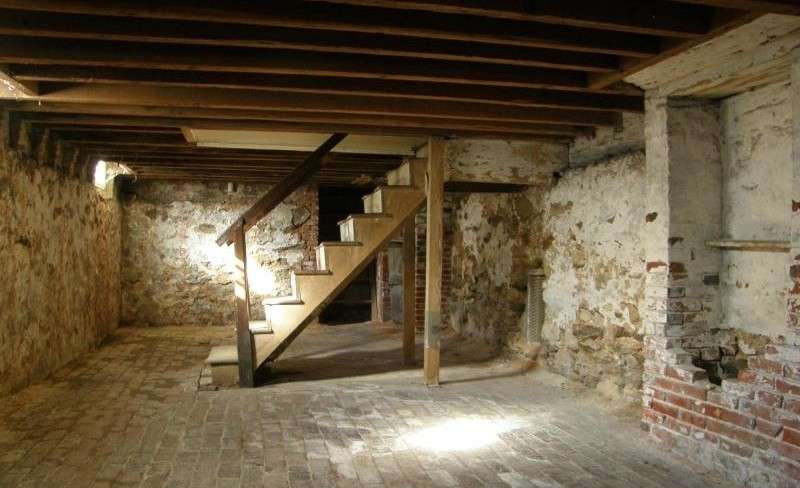
Best Basement Dehumidifier Reviews
Frigidaire FFAD5033W1 Dehumidifier
Our favorite basement dehumidifier has now been replaced by our new favorite dehumidifer, the Frigidaire FFAD5033W1. Frigidaire have combined high performance with reliability to create the only dehumidifier you’ll ever need.
Although labelled as a 50 pint dehumidifier (due to new legislation), this model has the same performance as the previous FFAD7033R1 70 pint dehumidifier which is more than adequate for most basements, even if you’re lucky enough to live in a large house. It’s very energy efficient due to its above average moisture removal rate which has been measured by our in-depth testing process. This high moisture removal rate is also the number one reason why we recommend it over other dehumidifiers in this category.
It’s also very quiet for a dehumidifier in its size class, no matter which of the 3 fan speeds you use. The FFAD5033W1 scored above average test results in every one of our noise emissions tests. Superb energy efficiency, a great moisture removal rate, and low noise output are all qualities that make it one of the best compressor-based dehumidifiers you can buy.
The Frigidaire FFAD5033W1 is our choice for the best dehumidifier for basements.
Read our full Frigidaire FFAD7033R1 review.
hOmeLabs HME0200031N Dehumidifier
A good alternative to Frigidaire dehumidifiers, hOmeLabs are a relative newcomer to the basement dehumidifier market. Despite this, their portable 70 pint energy star dehumidifier is perfect for basement use and is good enough to rival more established companies such as Frigidaire. Like the others we’ve reviewed, this large capacity dehumidifier is great for any large room, basement, or garage where you need to reduce humidity quickly and efficiently.
Like the Frigidaire, this dehumidifier is Energy Star certified which makes it economical to run over extended periods of time. Great for the environment and for your wallet too.
The hOmeLabs dehumidifier is easy to use too. Either make use of the continuous drainage mode if you have a drainage point nearby or rely on the internal water tank. The choice is yours, but the rate of humidity reduction remains the same.
The included drainage hose is a handy addition if you do intend to make use of a floor drain, nearby sink or other drain outlet to dispose of the water this unit collects.
We particularly like the turbo mode that increases the fan speed from the “Normal Air” setting of 165 CFM (cubic feet/minute) to the “High Air” setting of 188 CFM. Using this turbo mode maximizes efficiency and improves the water removal rate.
A great alternative for those comparing dehumidifiers for basements.
TOSOT 70 Pint Dehumidifier
TOSOT is another new company who have created a fantastic little portable dehumidifier. Like the others, its rated at 70 pints of moisture per day or every 24 hours which is sufficient for even the wettest and dampest of basements.
Its powerful and removes moisture from the air quickly and provided us with continuous dehumidification for over a week during our testing period.
This dehumidifier is available in two versions, one of which has a built-in pump. If that’s a must have feature, be sure to order that one when you buy. You also get 2 different operating speeds, an auto defrost mode, auto restart, and an auto shutoff function. Both models also come with a direct drainage outlet as well as an LED display with electronic controls.
The onboard filter requires cleaning every 250 hours which means that it shouldn’t need to be done any more frequently than once a month. If your basement is significantly damp, this duration will be shorter.
Ivation 70 Pint Dehumidifier
Made by Ivation, this efficient Energy Star model is an excellent dehumidifier that’s a great choice for rooms and internal spaces measuring up to 5,000 square feet in area.
Our favorite feature is the easy to read RH indicator with its simple yet effective LED display. This allows you to check and monitor the humidity level whenever you want and then set the desired level through the automatic moisture control system. There are two modes of operation; regular and turbo mode which represent two different fan settings.
Other stand out features include a 24-hour timer and a “Quick Control” switch, in addition to the useful Auto-Restart technology which saves your current settings and automatically turns the unit back on after a power outage.
This model is slightly louder than others but we didn’t find this an issue due to where its going to be used, so we wouldn't let the noise level concern you too much. The Ivation truly is a fantastic 70 pint dehumidifier.
Vremi 70 Pint Dehumidifier
Vremi are known for producing a range of home and kitchen-based appliances but have recently expanded into dehumidifiers. Despite this short track record of manufacturing air quality focussed appliances, this dehumidifier is good enough to make it onto our list of recommendations.
If you are keen on protecting the environment or wish to save a few dollars each month on your electricity bill, the first thing you will notice about the Vremi dehumidifier is that it is Energy Star certified. This means it will remove moisture in the air and the humidity from within your home with minimal energy consumption.
Vremi designed the Moisture Maniac dehumidifier with convenience in mind. The built-in caster wheels and sturdy carry handles allow you to move it around the house quickly and easily. This portable dehumidifier is also very quiet (almost as quiet as the Frigidaire), ensuring that you will not hear it running in the background as it removes moisture, odors and allergens from the air.
Operation is simple – just set the desired humidity level for your basement and then let the dehumidifier do its job. It will run in continuous 24-hour cycles until the water tank is full where you can then either empty it yourself or make use of the drain hose for hassle free continuous drainage.
Basement Dehumidifier Buyers Guide
The basement in your home is a great place to store things that you rarely use. But its also a fundamental part of your home as it forms part of the foundations and structure.
Due to the enclosed nature of most basements and cellars, they’re a breeding ground for dust, mites and a variety of insects such as wood lice and wood beetles. This lack of airflow as well as the lower temperatures common to basements is also the perfect recipe for damp.
Combine all these factors together and you quickly begin to see why the basement is often at the core of many property related problems.
The quickest way to fix this problem and to prolong the life of your basement is by using a dehumidifier. A powerful dehumidifier will quickly reduce the moisture content of the air underneath your home which will immediately slow the spread of damp and timber decay.
The recommended level of humidity for your basement is between 30 and 50% RH (relative humidity). Anything greater than this number will assist the spread of damp, condensation and mold growth. If your basement has a humidity level of 50 percent or higher, it is likely you need a dehumidifier.
Once the optimum level of humidity is achieved and maintained, your basement will become a far nicer place to be and will ensure that whatever is stored down there is also kept in good condition.
Features to Look For When Buying a Dehumidifier for Your Basement
There are several features which make some dehumidifiers better than others in this environment. The ones you should look for depend on the layout of your basement and the type of performance you’re looking for. Each of these features combine to make the best dehumidifier for basement use.
An Internal Condensate Pump
Your dehumidifier will need to run intermittently throughout the day. As it collects water, this water will need to be disposed of. The easiest way to do this is by pumping it out through the nearest floor drain, sink or window via the continuous drain feature. Doing so will prevent you from having to rely on the internal water bucket.
A built-in pump will allow you more flexibility in where you place it, as a unit without a pump will require you to place it at a height which is above where its being drained into. This is just how gravity drainage works.
Using the internal pump involves attaching a drain hose and ensuring it's placed into a suitable container or near to a floor drain. A section of garden hose can be used if the dehumidifier you buy doesn't come with one.
An Air Filter Indicator
All air filters require cleaning over time. This handy light will prevent you from having to guess when to clean the built-in filter.
An Automatic Humidistat
This feature constantly monitors the humidity level of the air. Once the desired level of humidity has been reached, the unit will shut off to conserve energy.
Once moisture has started to return, it will switch itself on again to maintain the appropriate humidity level (50 percent for example).
Most humidistats are operated via a digital control panel which includes a humidity readout. Whether you're using a dehumidifier in an apartment or a basement, this feature is important.
A Low Temperature Setting
Basements are cold. Dehumidifier technology will only work down to a certain air temperature. Because they rely on refrigerant, their components also become very cold when in use.
Low temperature functionality will allow your dehumidifier to work unaffected in the coldest of ambient temperatures.
If your basement is extremely cold, you may be better off with a desiccant dehumidifier as they have a lower operating temperature range. Desiccant dehumidifiers also output heat which is a useful benefit for unheated spaces.
If your basement is very cold, take a look at the Alorair Sentinel hdi90 which is designed to work in low temperatures and even freezing temperatures. The hdi90 does this by defrosting cold coils so they never freeze.
Auto Defrost Functionality
This function will defrost the refrigerant coils after they become frozen due to prolonged use in a cold environment with a low room temperature. Coils frozen with ice as well as general frost buildup is a normal occurrence in compressor dehumidifiers.
Auto Reset Capability
You might not want to take a trip down to the basement unless you really have to. This auto-restart feature then becomes important as it allows your dehumidifier to switch itself back on after a power outage.
Energy Consumption
The energy requirements of your average dehumidifier are a valid concern. It could cost anywhere between $15 and $50 to run a dehumidifier depending on the size and humidity levels of your home.
If you would rather spend less money on your electricity bill, be sure to look for an Energy Star certified model which are up to 30% more efficient.
Noise Output
Most dehumidifiers are as loud as your average window air conditioner. The faster the fan is running, the louder your unit will sound during use.
Measured noise output ranges from 50 decibels (the sound of a normal conversation) to 65 decibels (comparable to street traffic) depending on the model you buy. Manufacturers aren't required to list this specification on product listing pages so you may have to look through operating manuals to find the information you require.
Alternatively, reviews like ours always make reference to noise output across the devices we test, allowing you to make a comparison.
A handy tip is placing your dehumidifier onto carpet or a completely level serface to reduce noise.
Sizing Capacity for Your Basement
Dehumidifiers come in a range of different sizes and power capacities. This biggest clue to how powerful a dehumidifier comes from its moisture removal rating which is measured in pints of moisture per day or every 24 hours (and sometimes litres). Buying the right size is the most important step in making sure you’re using your new basement dehumidifier as efficiently as possible.
A dehumidifier with a lower rating will have to run for longer to remove the same amount of water from the air per day. This will negate any energy bill savings that the lower power capacity would have granted you.
A higher rated dehumidifier will remove water from the air faster which means that it will switch itself off faster. The result is a drier, less humid basement and lower monthly electricity bills.
As you can see, the more water per day removed the better.
There are two recognized steps to finding the correct size dehumidifier for basement areas. This process can also be applied to a crawl space.
Looking for a crawl space dehumidifier? Read our buying guide for more information.
Basement Square Footage
Having an idea of the total area of your basement will help you to find the correct dehumidifier power level. The Association of Home Appliance Manufacturers (AHAM) have standardized dehumidifier sizing. This data simplifies the process and takes the guess work out of choosing between models.
As an example, a basement of 2,000 Sq. Ft. is said to need a dehumidifier that removes around 25 pints of moisture (pints of water) every 24 hours. More on this later.
Once you know the overall area to be dehumidified, correlate that to the power rating and pint removal capacity of the dehumidifier you wish to buy. Many manufacturers have a sizing chart that can assist you when comparing products as a consumer.
Basement Humidity Levels
The second step involves measuring the existing internal humidity level in your basement. This can be done with the use of a hygrometer which is a thermometer which can also measure relative humidity.
Your basement’s humidity will vary throughout the year depending on season and whether it is winter or summer. Your geographical location and the local climate will also have an impact on humidity levels, with some parts of the country suffering from high humidty much more than others.
If you live in an area that has a climate with persistent high humidity, you will notice an increase in internal humidity. A higher rated pint capacity dehumidifier will be necessary to remove more pints of water per sq ft per day. Due to this continuous use in climates with a high humidity, a permanently placed dehumidifier in the basement is a good option for many homeowners.
An excessively damp basement (60% + relative humidity) will require a more powerful dehumidifier but those with humidity levels less than 40% RH might be fine with a lower rated model such as those classified as 30 pints.
That is the scientific approach, but as we mentioned, more powerful is almost universally always better. For this reason, our favourite dehumidifiers for basement use are all in the 70 pint category.
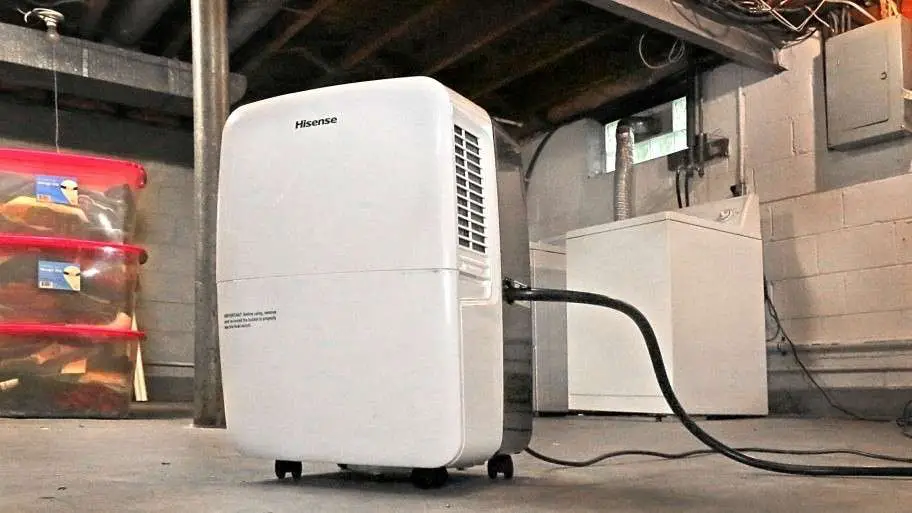
A dehumidifier running in a basement
The Symptoms of Excess Basement Moisture
We're all familiar with that unpleasant and familiar sign of damp that covers your skin and fills your nose when you walk into a room. There are several other signs that you might notice within your home. If you experience just one of these symptoms, it's a sign that you need to start using a dehumidifier in your basement or cellar.
Common Signs You Need a Dehumidifier
- Continued mold growth on walls and windows even after repeated cleaning and removal
- Condensation or visible water droplets on your windows as well as water collecting on the internal window sills
- Damp stains or water tide marks on painted surfaces or ceilings
- A damp feeling to the air
- Damp, mold and mildew in the corners of rooms and throughout crawl spaces
- Walls always feel damp to the touch
- Furniture and other items may be covered in mold and mildew or have a damp smell
- Peeling, flaking or cracking paint
Even just a few of these symptoms is a guarantee that you have a problem with excess moisture, damp and excess humidity.
Looking for the best garage dehumidifier? Take a look at our guide.
Benefits of Using a Basement Dehumidifier
The beneficial effects of using a dehumidifier can be felt throughout your home, your overall health and in your pocket. Dehumidifiers are much cheaper than they use to be and offer great value when you consider their benefits which include:
- Reduced moisture levels reduce the presence of mold and mildew, both in your basement and throughout your home. This in turn improves the air quality in your home by eliminating mold spores and dust mites.
- Cleaner air results in healthier lungs. One benefit is a reduction in the symptoms typically associated with poorer air quality. Such symptoms include respiratory illnesses, sinus inflammation and other associated medical conditions.
- The lifespan of painted surfaces, metal and wooden furniture and all upholstery will be increased thanks to reduced or completely eliminated mold and mildew. Drier air will also prolong the life of furniture and electronics.
- A basement dehumidifier will reduce dust levels throughout your home.
- A basement dehumidifier will reduce the loading on any air conditioners you have installed throughout your home whether upstairs or downstairs. An air conditioner has to work harder to cool air and remove water from it in humid environments. If the air within your home is drier, your A/C will operate with greater efficiency which will in turn lower energy costs.
- Houses constructed from timber can be negatively affected by excess moisture, excess damp and high humidity. Timber window frames and structural beams (roof / floor / walls etc) can warp and rot and metal fixtures and fittings rust more easily. Removing excess damp will protect the physical structure of your home by keeping it drier and in better condition for longer.
Final Verdict: Best Dehumidifier for Basement
Each dehumidifier we’ve tested makes a great dehumidifier for basement use. You can either choose our top recommendation, which is the Frigidaire dehumidifier, or instead choose one of the others if you feel they’re more suitable.
There is a slight difference in price between each model which we know will sway some peoples decision, but rest assured, you’ll be buying the best basement dehumidifier whichever one you go for.
Looking for more recommendations? Consult our best dehumidifier rankings.
Resources:

